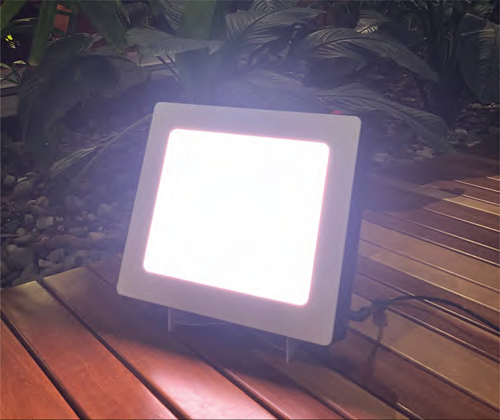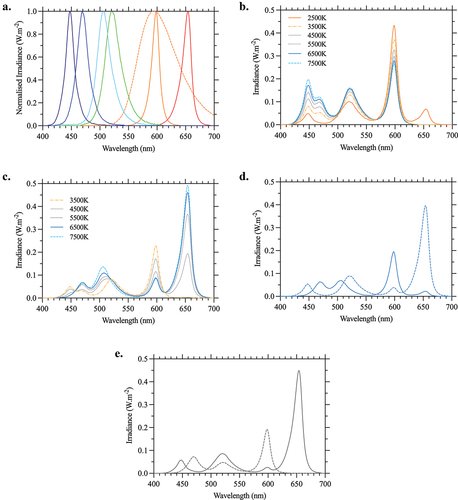Figures & data
Fig. 1. A portable photoreceptor enhanced light therapy (PELT) device with spectral components optimized to provide a gamut capable of generating circadian equivalent photoreceptor-directed light. The PELT stimulation protocol is specified with reference to the excitations of all five photoreceptor classes in the human eye and written to the microcontroller via a USB connection accessed through a port on the back of the device. Power is connected via the right-side panel. A protocol is started using the red button on the top right corner of the device. A notification speaker can provide alerting sounds for compliance.

Fig. 2. Circadian equivalent photoreceptor-directed light spectrums implemented in the PELT device. (a) Normalized component spectral outputs of the six primary lights (solid lines) and the replacement primary (dashed line). All lights are specified with reference to their excitation ratios of the three cones (L-, M, S-), the rhodopsin (R) and melanopsin (i) photopigments. (b) Spectra designed as daylight metamers across all five photoreceptors at correlated color temperatures (CCT) between 2500 and 7500 K (). The spectra can be programmed to change dynamically and match the photoreceptor excitation ratios with time of day or be set to a static spectrum with the five photoreceptor excitation ratios matching the specific time of day as designated by the CCT and preferred by the user. (c) Photoreceptor directed (PrD) spectra having the three cone excitations set to a reference CCT (e.g., 3500 K) and a circadian equivalent (CE) melanopsin and rhodopsin excitation set at a higher CCT (e.g., 4500–7500 K). The appearance of all higher circadian equivalent lights matches closely with the 3500 K reference white. The change in color appearance of the white light due to the higher melanopsin and rhodopsin excitations is circumvented by applying cone corrections (Δl, Δs at equiluminance), but which introduce minor deviations in the evaluated CCT (). (d) Personalized spectral outputs for a PELT protocol that selectively alters the melanopsin excitation between a depleted (dashed line) and enhanced state (solid line), with reference to a ~3500 K light. This circadian equivalent increase in melanopsin excitation approaches 5500 K (Δ24% melanopsin Weber contrast) (). (e) Personalized spectral outputs for a PELT protocol that selectively alters the rhodopsin excitation between a depleted (dashed line) and enhanced state (solid line), with reference to a ~3500 K light. This circadian equivalent increase in rhodopsin excitation approaches 5000 K (Δ15.5% rhodopsin Weber contrast). Although the maximum melanopsin or rhodopsin photoreceptor directed contrasts are achieved using nonwhite chromaticities with the implemented spectral components, the practical settings generate a white light with high PrD contrasts by allowing a small tolerance in the unmodulated photoreceptor contrast ().

Table 1. The five photoreceptor excitation ratios for typical daylight, circadian equivalent photoreceptor-directed lights (PrD).
Table 2. Practical circadian equivalent stimulation settings for photoreceptor-enhanced light therapy (PELT).
Data availability statement
Data underlying the results presented in this paper may be obtained from the authors upon reasonable request.
